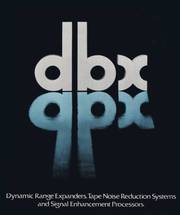dbx - wie man das Rauschen unterdrücken kann oder könnte
Das Rauschen bei den Tonbandgeräten war bereits 1935 ein dickes Problem. Teilweise konnte das etwa 1941 durch die HF-Vormagnetisierung drastisch verbessert werden. Doch befriedigend war es immer noch nicht. Die bestenbandgeräte schafftengerade mal 68dB Dynamik. Und so erdachten mehrere Spezialisten diverse Methoden, das in den Griff zu bekommen. Einer von Ihnen war 1971 ein David E. Blackmer. Er war mit der von Ray Dolby entwickelten Rauschunterdrückung nicht zufrieden oder einverstanden. Die Werbetexter der Firma dbx verklären das bis zum Märchen.
.
Wir beginnen mit dem ausführlichen dbx Prospekt von 1978
Der Werbetexter führt aus :
From its beginning in 1971, dbx made the commitment to develop the next generation of music reproduction technology. The founding inventors and engineers have continued to meet the challenge of this commitment, from the introduction of the first dbx consumer product, the 117 Dynamic Range Enhancer, through the current line of audio products and those on our drawing boards, dbx has consistently manufactured and marketed audio components which not only advance the state-of-the-art in their class, but also move high fidelity closer to its stated goal: to erase any perceivable difference between live and recorded music.
dbx makes products for the home and for the large and small recording studio. These include expanders, tape noise reduction systems, compressor/limiters, subharmonic synthesizers, decibel meters, voltage-controlled amplifiers, and accessories. Each dbx product passes individual quality control and testing procedures before it leaves the plant. More than 25 percent of dbx's production force is devoted to these quality assurance procedures, independent testing organizations, as well as high fidelity critics and publications consistently award their highest ratings to dbx equipment.
dbx products are manufactured entirely in the United States from the highest quality components, inside - and out, where their matched, solid walnut sides and solid aluminum knobs give them their distinctive character, dbx products are available from better audio dealers throughout the United States, and all over the world.
dbx corporate headquarters and manufacturing facilities are located in the Boston, Massachusetts area.
.
The Live Concert.
Listening to a live musical performance is one of life's greatest experiences. Your ears hear the subtlest pianissimos, and the most thundering fortissimos. The difference in volume between these extremes is called dynamic range. It is measured in decibels or dB. The human ear can hear sounds ranging from 0 to 130 dB of sound pressure level. Any sound louder than that causes pain. The range between quiet and loud portions of live music can be up to lOOdB. It is this dynamic range that gives us the contrast and startling intensity of a live concert, whether it's the intimacy of a string quartet, the power of a symphony orchestra, or the sheer energy of a good rock group.
The Dead Concert.
Unfortunately, that intensity is altered in the recording and broadcast process. Due to technical limitations of records and tapes, the dynamic range of sound you hear over your hifi system - no matter how good your hifi system is - it is typically 25-40 dB, and at very best, only 60 dB. What happens to the other 40-75 dB ? It gets compressed, or chopped off altogether. So when you compare what you hear at a live concert to what you hear over your hifi, you notice that the resulting music sounds as if it were flattened, or muffled in some way. It lacks the punch and definition of a live concert. Sounds are muddied, because the quiets are made louder, and the louds are made quieter. The loud and quiet sounds are all pushed towards the middle.
A Solution - Dynamic Range Expansion.
Dynamic range expansion reverses the compression process that occurs in recording and broadcasting. It restores the space between quiet and loud. When you use an expander, louds get louder - just the way you hear them at a live concert - and quiets get quieter - just the way you hear them at a live concert. But some expanders operate only on a portion of the signal. This throws the music's balance out of proportion. These expanders caricature your music, instead of restoring its missing dynamic range.
The Solution - The dbx Linear Dynamic Range Expander.
Only dbx has solved this problem. We have developed the first linear expanders which expand all frequencies and all levels over the entire dynamic range, by the same proportion. That means expansion occurs not only at the louder levels, but also at the quieter levels, indeed, over the entire dynamic range.
The keys to this expansion are two patented devices. The dbx rms detector senses the entire dynamic content of the music. It then instructs the dbx voltage controlled amplifier to precisely increase or decrease level, instantly.
Records, Cassettes, Broadcasts - All Sound Astonishingly Better Through Your Expensive or Inexpensive HiFi.
No matter how great your system is, you will want to re-play all your tapes and records again through a dbx linear dynamic range expander. You'll hear things you never heard before ... more music. And you won't hear things you did hear before ... noise (a pleasing side effect of the dbx linear expanders). It will be like listening to your tapes and records for the first time. Only better. And, of course, it goes without saying that a more modest system will also be greatly improved. You'll hear the soft brushwork of a drummer and the loud crescendo of the kettle drums. Every nuance and texture of a symphony string section will have incredible presence. The sharp attack of a brass section jumps out of the speaker. Bass notes regain their punch and clarity. As a matter of fact, we'd like to offer you a friendly challenge. If you think your system can't be improved, drop in on your dbx dealer and listen to a similar system with a dbx linear expander. The difference will startle you. And that's a promise.
Weitere dbx Erklärungen (Teil2)
Tape Noise - Why Worry About it ?
Maybe you've become accustomed to a little noise coming through your speakers. But why add to it when you do any live recording, or tape copying? Unless you record with a dbx II Tape Noise Reduction System, that's exactly what will happen. Your machine will add audible noise to your music.
Tape Noise - Why Do We Have It In the First Place ?
Much as we'd like to get rid of it, tape noise is inherent - even with the best studio tape recorders. It's caused by the iron oxide particles on the tape passing over the record and playback heads.
More Noise Means Less Music
Recording engineers allow for tape noise by reducing the dynamic range (the space between loud and quiet portions of recorded music). And that means you hear less music. The music you do hear sounds squeezed, or compressed. This is done so that quiet sounds will not get buried in the noise, and loud sounds don't overload the tape. So the recording engineer makes the quiet sounds louder, and the loud sounds quieter. And that certainly is not what the composer had in mind when he wrote the music.
How to Throw Out The Noise Without Throwing Out The Music
1. DOLBY® "B"*, OR GETTING RID OF SOME OF THE NOISE
The Dolby "B" noise reduction system reduces high frequency tape noise by approximately 7 to 10dB. That's not bad. But while it reduces high frequency noise in quiet passages, it leaves low frequency noise right where it was. In your ear.
2. dbx II, OR, GETTING RID OF ALL OF THE NOISE
The dbx II Tape Noise Reduction System reduces tape background noise by 30dB at all frequencies. And that's more than just OK. That's better than any other system, dbx II also increases tape headroom by some 10dB, and significantly reduces the risk of tape overload (putting sounds on tape which distort because they are too loud). In playback, you'll get a mirror image indistinguishable from the original music source - with absolutely no audible noise added by the tape recording process.
Why dbx II Is Better Than Dolby "B"
.
Anmerkung : Solch eine Frage oder noch heftiger, solch eine Aussage war nach dem damals geltenden deutschen Wettbewerbsrecht strickt verboten. Also vergleichende diffamierende Werbung war sehr teuer, bei uns in Deutschland jedenfalls. In den USA war das schon immer erlaubt und wurde auch weidlich ausgebreitet.
.
The Dolby "B" system is inherently non-linear, operating only below a certain threshold which must be level matched during recording and playback. This step is difficult at best, so nobody seems to bother. And most tape decks with built-in Dolby don't even have accurate level matching capability.
The dbx II Tape Noise Reduction System, on the other hand, operates linearly at all frequencies and over the entire dynamic range. That means level matching procedures are unnecessary. Moreover, you will hear a vast amount of noise reduction over the entire dynamic range, and at all frequencies, and not just at low level signals at high frequencies.
.
How the dbx II System Works
You might want to add a new word to your vocabulary. Compander. It describes how a dbx II works (compression and expansion). First, during recording, all levels are linearly compressed by one half over the entire audio spectrum.
It then becomes an easy matter to place the signal on the tape comfortably above the noise level, and below the point of tape saturation. Then, upon playback, the signal goes into the unit's expander section, which linearly expands and restores the dynamic range to exactly what it was on the original.
The key is a true rms detector, an ingenious device which precisely and instantly measures the dynamic content of the music. The patented dbx voltage controlled amplifier answers the rms detector's commands to precisely increase or decrease level during recording and playback. The end result is an exact, mirror image reconstruction of the original music, with no audible noise added, and fully preserved dynamics.
Listen To It. Just Listen To It.
You'll be amazed at what you don't hear.
- Anmerkung : Irgendwann um 1973 bekam ich meinen großen 3BX super 3-band Expander. Ich habe dann Wochen (ja fast Monate) lang gehört und gelauscht und justiert und probiert. Die Infinity Servostatic 1 war mit den Elektrostaten sowieso schon sehr dynamisch bei leisen und mittleren Lautstärken. Es war aber doch nicht so begeisternd und erhellend bzw. befriedigend, wie es der amerikanische Autor hier anpreist. Die Musik klang nicht mehr natürlich, sondern aufgeregt und spitz. Als ich das mit meinen Bekannten aus den Rundfunk- und Tonstudios hier im Umkreis so diskutiert hatte, sagten die mir, alle dbx Geräte seien bei ihnen wieder aus dem Betrieb genommen worden. Bei den analogen Bandmaschinen war die Zeit nach 1985 am Auslaufen und das professionelle (und teuere) DOLBY-C System würde vor allem nicht pumpen. Und die von mir bemerkten schrillen Spitzen mache DOLBY-C auch nicht. Mit den DOLBY und dbx Hobbygeräten hätten sie sich aber nie beschäftigt. - Im Winter 2017 habe ich eine TASCAM ATR-60-8 samt professionellem 8-Kanal dbx bekommen. Das werde ich jetzt nochmals genauer testen, das mit dem Pumpen der billigen Varianten.
.


